| |


Aircrew
Remembered
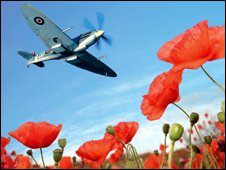
We
are featuring Aircrew and veterans of WW2 in memory of their great bravery and
sacrifice.
If you have a story to tell Please forward it to us and we will put
it on the website.
SQUADRON LEADER DAVE GLASER D.F.C
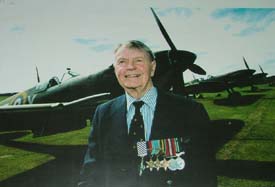
A Great man someone I was
proud to call my friend.

Churchstanton later known as Culmhead in Somerset UK was an
operational fighter station throughout the second world war.
On one of my many visits to this airfield I found a rusty piece of metal
sticking out of the ground. As I picked it up I noticed a name painted on it in
remarkably good condition. The name was Flt Lft Glaser, I was amazed this had
survived for 50 years and wondered about the Pilot behind the name. When I
returned home, using the power of the internet I sent an email to Douglas Tidy of
74sq Flying Tigers {Author of the book." I Fear No Man" History of 74 sq and asked
him if he had heard of a pilot called Glaser. Amazingly he had heard of a PO E D
Glaser who flew with 65sq in 1940.I then looked at the Battle of Britain roll
which also listed PO E.D Glaser of 65sq.
Jim Corbett from Newcastle sent me a list of sqs that served at Culmhead.
However there was no mention of 65sq ever having been there. Not giving up Jim
looked through his books to see if ED Glaser had ever been shot down and came up
with the following." Flight Lieutenant E.D Glaser of 234sq flying Spitfire
BL427,combat with JU88 off Falmouth. Baled out into the sea, rescued by
minesweeper. Jim then checked the sq list and found that 234 was at Culmhead from
24.6.43 to 8.7.43.
Doug Tidy then told me that Sdr Ldr E.D Glaser was a member of the Battle of
Britain Fighter association in 1999.After a few phone calls I managed to get a
letter forwarded to Sdr Ldr Glaser via the Fighter association.
A few days later I had a phone call from a very real Sdr Ldr Glaser. He was as
amazed as I was and told me that he had only been at Culmhead for two weeks.
While
there he was flying with a ninety gallon drop tank attached to his Spitfire. In
his log book is recorded a flight of 5hrs 10mins.
I asked him about the action with the JU 88.He was attacking this aircraft at 0
feet as it attacked a minesweeper. Lining up his site he was took several hits
not from the 88.He looked all around for an escorting fighter but none was
visible. His engine then stopped dead and he pulled back on the stick as his
airspeed rapidly dropped. Flt Lft Glaser decided it was time to leave. He bailed
out and his chute filled as he hit the water. The chute then came down on his
head and threatened to drag him under. He struggled to free himself and finally got
clear. Soon after the Minesweeper pulled up and full of apologies pulled him
onboard. It seemed that as they shot at the bomber they had hit the Spitfire.
Sdr Ldr Glaser D.F.C came to visit me with his wife Roddy. We visited
Churchstanton and I was amazed at his youthful appearance and fitness. This was
the first time I had ever met a fighter pilot. I was enthralled by his
experiences, he is a most modest and honourable man with a great sense of humour
and the vigour of a 20 year old.
Graham
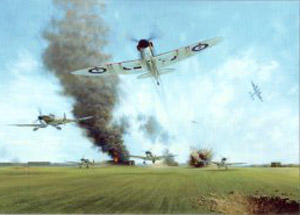
This picture is of Pilot Officer Dave Glaser taking off on
the 12th of August 1940 in a 65 Sdr Spitfire. This picture hangs over my fire
place.
Picture of Dave with 65
Sdr in 1940
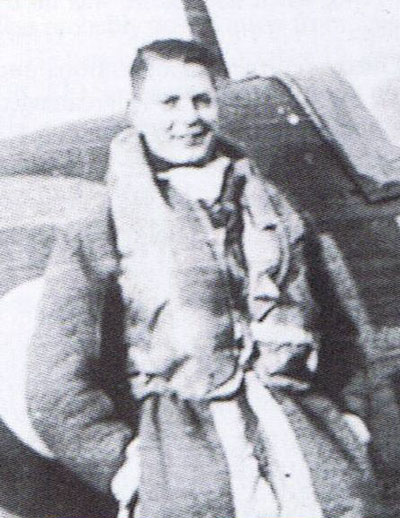
Dave Glaser Northern Territories 1945
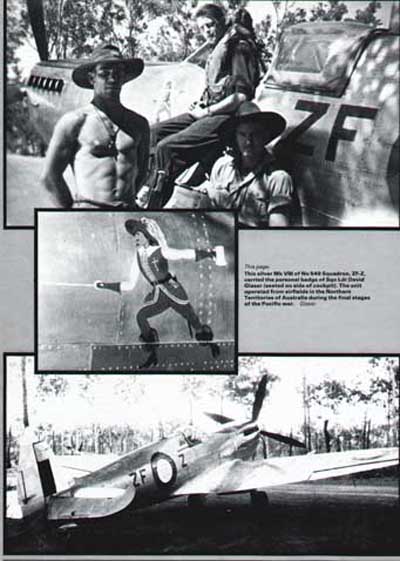
SQUADRON LEADER DAVE GLASER, who has died aged 80, was an RAF
pilot mistakenly shot down off Plymouth, Devon, by a British warship during the
Battle of Britain.
Struggling to free himself from his parachute, which had enveloped his head,
Glaser had all but given up hope when the chute floated away and he was rescued.
Aged 19, Glaser had joined No 65 Squadron at Hornchurch on July 13 1940, just
three days after the date regarded as the beginning of the Battle of Britain,
which raged overhead until October 31, when the RAF's supremacy ended the threat
of German invasion.
Ernest Derek Glaser, always known as Dave, was born on April 20 1921. In the
First World War his father had been a pilot in the Royal Flying Corps. After
attending Lancing House and Bloxham schools young Dave was accepted, in April
1939, for flying training in the Royal Air Force Volunteer Reserve.
Glaser had been inspired to become a pilot some years earlier after meeting
Jeffrey Quill who, in 1936, as a Supermarine test pilot, had flown R J
Mitchell's Spitfire prototype and earliest production aircraft. Quill had been a
frequent visitor to The Bugle, Glaser's father's pub on the Hamble in Hampshire.
In 1940, Quill was temporarily attached to No 65 Squadron for - as he put it -
"a spot of practical" in order to recommend modifications in the light of combat
experience. Glaser was delighted, on his arrival, to find himself flying No 2 to
his boyhood hero.
Glaser soon had examples of combat himself. On August 12 he was preparing to
take off from Manston when a formation of low-flying Dornier 17s attacked the
airfield at low level, damaging hangars and cratering the flight-path. Glaser
recalled: "Everybody just opened up their throttles and went hell for leather."
Awaiting the scramble bell during the Battle of Britain Glaser had occupied
himself by fashioning a lucky talisman representing The Laughing Cavalier.
Glaser reckoned that, together with a cavalier which he had had painted on his
Spitfire (in an example of what was known as nose art), it helped to see him
through the war.
In this period he was promoted flight lieutenant and was serving as a No 234
Squadron flight commander when he was shot down into the Channel off Plymouth in
Devon. Vowing to be more circumspect in the vicinity of the Royal Navy, Glaser
resumed operations with Group Captain (subsequently Air Chief Marshal Sir Harry)
Broadhurst's Spitfire wing based at Hornchurch, Essex, but frequently operated
from Manston, the Kent coastal airfield, and other south-east England No 11
Group airfields.
Following the Battle of Britain, in 1941 Glaser became an instructor at No 53
Operational Training Unit until August, when he joined No 234, a Spitfire
squadron carrying out offensive sweeps over northern France. In 1943, Glaser was
posted to Australia to form and command No 549, a Spitfire squadron stationed at
Darwin in the Northern Territory.
In the New Year of 1945 he received command of No 548, a Spitfire squadron
similarly charged with defending Darwin against Japanese air attack. After two
years he returned home, was granted a permanent commission and posted to
Linton-on-Ouse, Yorkshire. There he was flight commander of No 64, a
half-strength Hornet fighter squadron.
Glaser was delighted in 1949 when he was selected to qualify as a test pilot,
again following his hero Jeffrey Quill. Glaser attended No 8 Course at the
Empire Test Pilots' School, then situated at Farnborough, Hants (and now based
at Boscombe Down, Wiltshire).
In 1950, Glaser was employed as an RAF experimental test pilot at the Royal
Aircraft Establishment, Farnborough, until 1953, when he joined Vickers
Armstrong at Hurn, Bournemouth, Hants. Becoming chief production test pilot,
Glaser was involved with the Varsity. This was a post-war replacement for the
trainer version of the two-engine Wellington bomber. He also tested the world's
first turbine-powered four-engine airliner, Sir George Edwards's Viscount - a
plane then described as "a jump into the future".
But his chief contribution was his exhaustive production testing of the Valiant,
the first of the RAF's four-jet bombers, which preceded the Vulcan and Victor in
Britain's V-bomber nuclear force. Glaser was also involved with the BAC 1-11s,
one of Britain's best selling airliners. When, in 1963, he first flew the jet,
he handled it like a Spitfire and was apt to fly over Hurn airfield so low that
onlookers were put in mind of a Flymo.
In 1979 Glaser was appointed flight operations manager and test pilot instructor
of Rombac, an arrangement under which BAC 1-11s were built under licence in
Romania, where his robust airmanship was much admired his pupils. Glaser retired
in 1983 from British Aerospace - as Vickers, BAC and other merged aircraft
manufacturers had become - and worked as an aviation consultant, while deriving
much pleasure from sailing.
He was also invited to join a roadshow of British, American and German Second
World War pilots, which toured American theatres under the billing A Gathering
of Eagles. Glaser received the DFC in 1942 and Air Efficiency award in 1946. He
was awarded Queen's Commendations for Valuable Service in the Air in 1953 for
military, and in 1968 for civil, test flying.
Glaser married, first, in 1949, Coral Gillie, an Australian. They had a son and
a daughter. He married, second, in 1965, Diana Stewart-Smith, and, third, in
1985, Rodica Ghita, a Romanian.
I received the following
email from Dave Hanst
I first met Dave Glaser in December of
1955. I was a pilot flying for Capital Airlines, based in Washington, DC,
Capital had ordered fifty of the Vickers Viscounts, I was one of the flight
crews ferrying the planes from England to the U.S. We stayed at a hotel in
Bournemouth, near Hurn, where the Viscounts were built. Dave Glaser was a
test pilot with Vickers, the Capital pilots would go along on the test flights
to learn about any problems with the aircraft they were to ferry across the
Atlantic.
I was really impressed by Dave Glaser,
by his flying ability, his pleasantness, and in general by his attitude. He
never mentioned the fact that he had flown with the RAF during the war. I
wish I had known that, I would have liked to thank him for some of the escort
missions those fellows flew along to help me out. I was a B-17 pilot in the
Eighth AF, flying out of Bassingbourne with the 91st Bomb Group, the planes
with the triangle A on the tail.
As I mentioned, I did not know Dave
was an RAF pilot, I learned that fact a couple of years ago while watching a
documentary film on television. It was about the RAF, and there was Dave
Glaser, I got excited and yelled at my wife "I know that guy".
I had thought many times over the
years about trying to contact Dave, but had no idea of how to find him, I had
been back to England a few years ago, visited my old air base, that was while
Dave was still living, I would have loved to see him again.
Your story about him has been copied
into my computer.
Squadron leader Dave Hanst 322nd
Squadron, 91st Bomb Group of the Eighth AF
Dave is a Combat veteran of the aerial battle of WWII he
has kindly written this report of one of his missions and supplied the pictures.
We all owe these brave souls the freedom we enjoy today and my grateful thanks
go out to Dave and all the other aircrew who sacrificed so much on our behalf.
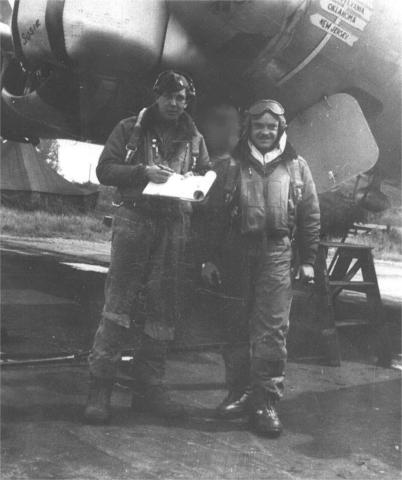
Dave is on the left signing his log book,
with Co Pilot Harry Rollinson.
Dave's B17 Flying Fortress "Hikin' for Home"
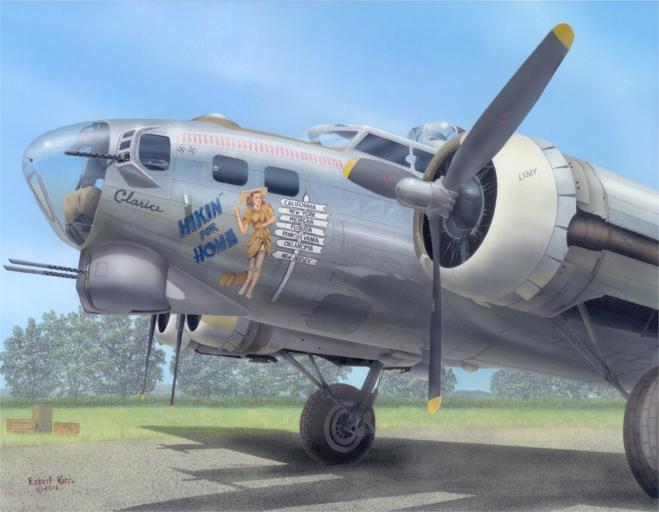
From a lithograph of a
painting by aviation artist Robert Karr, it sells on the internet for $75.00.
I don't know if you know anything
about Merseberg, Germany, the crews in the Eighth AF sure did. During the war
it was the largest oil refinery the Germans had. In the spring and summer of
1944 the Allies were concentrating on the destruction of the fuel output, and
transportation system of the Nazis. cont
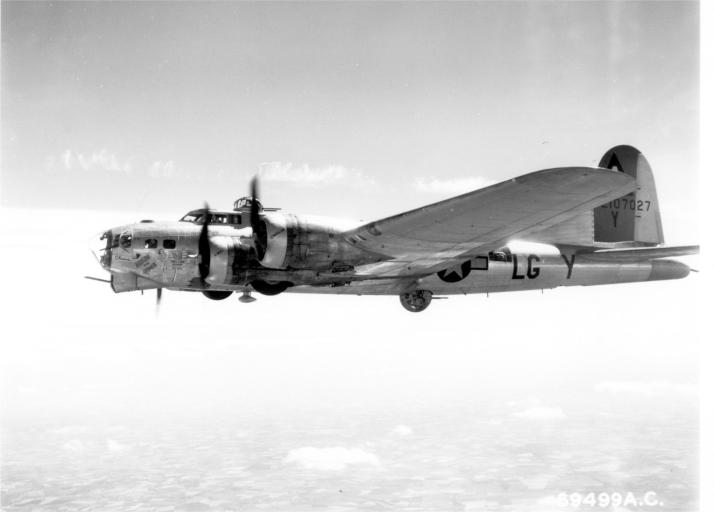
Dave's B17 Flying
Fortress "Hikin for Home"
Photo was taken over
England when I was checking my co-pilot out in the left seat.
The Germans were desperate to prevent
that from happening, the Merseberg refinery had over 800 flak guns protecting
the site. My final mission, on the 28th of July 1944, was to Merseberg, it
was almost a one way trip. Here is an account of that mission. cont
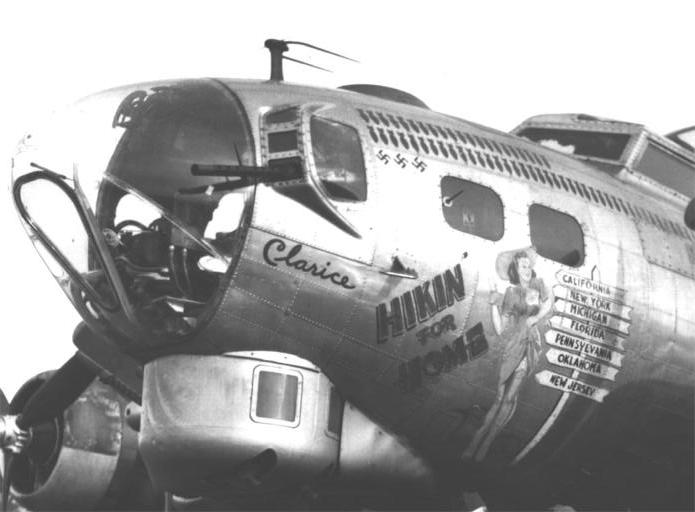
Dave's B17
Flying Fortress "Hikin for Home"
I was a squadron leader with the 322nd
squadron, 91st Bomb Group of the Eighth AF, flying out of Bassingbourn, just
southwest of Cambridge.
We departed at just about
sunrise, our target was the oil refinery at Merseberg. I was flying my own
plane "Hikin' for Home", leading the high squadron of the low group.
The target was clouded over when we
arrived, the Group Leader's "Mickey" system went out as we approached the
target, that meant we couldn't bomb through the clouds. A secondary target,
just a few miles away, was selected, as we crossed over the Merseberg/Leipzig
area hundreds of flak guns cut loose.
Here is a
picture, to show what the air over a target like Merseberg looks like when we
were being shot at.
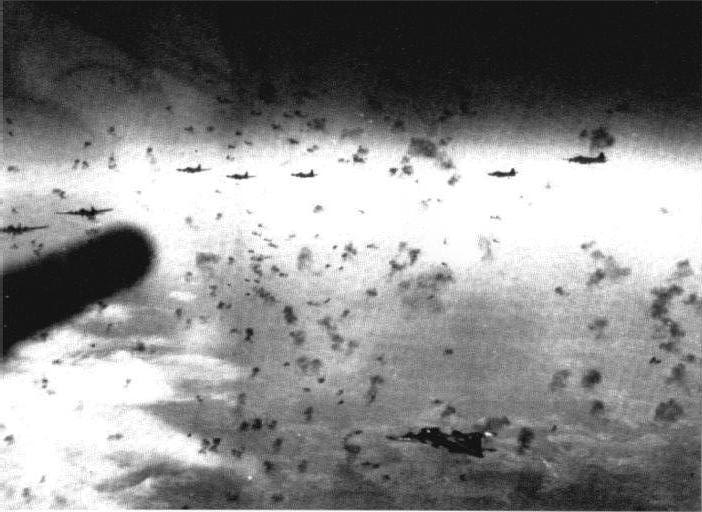
When those shells exploded you
could hear them, then see a red explosion, then smell the black, oily smoke.
It was scary because you never knew where the shells would burst next, German
fighters were bad enough, but at least you could see them to shoot at, flak
was a different story.
One large
fragment from an exploding shell bounced off my windshield, other pieces hit
my #2 engine and put it out of operation, I feathered it, was lucky
there was no fire since raw gas was pouring onto the hot cylinders. This was
almost a one way trip for me, one of the red hot fragments from the flak shell
went through the aluminium skin of the plane, it was headed straight for my
stomach when it hit a metal plate just twelve inches from me. I reached down
and picked it up, quickly dropping it because it was red hot. If that piece
had not hit that plate I wouldn't be writing this today.
Later I did get that
fragment, still have it today, here are a couple of pictures of it, and of the
patch on the side of the plane, where the ground crew covered the hole.
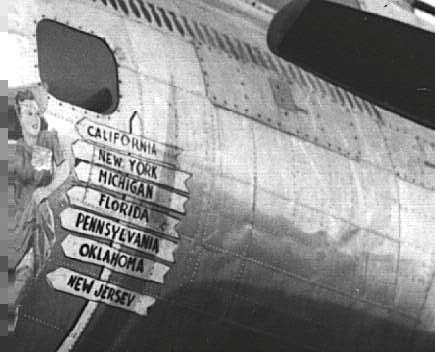
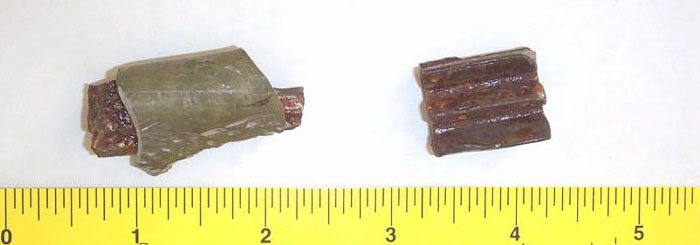
Later I did get that fragment, still
have it today, am enclosing a couple of pictures of it, and of the patch on
the side of the plane, where the ground crew covered the hole.
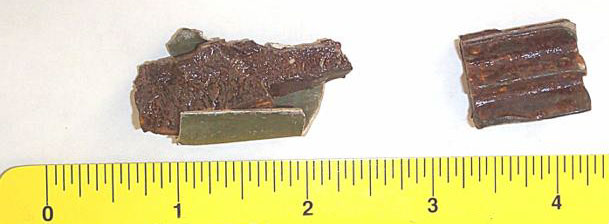
Dave today with his dog Boris.
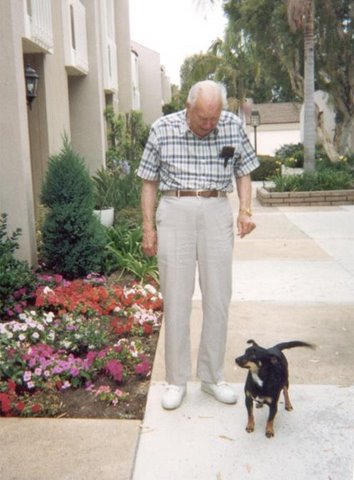
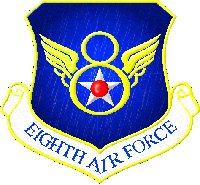
Author Dave Hanst 03/02/07
Grateful thanks to Dave for this
report .
Warrant
Officer Ernest Murray West
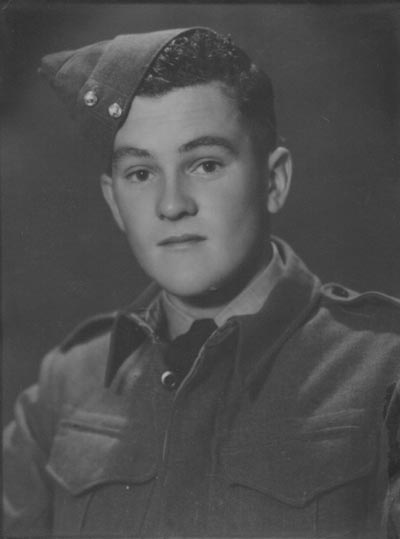
The
youngest son of four boys Ernest (Tink) learned to fly at the age of 15 in the
club’s DH Gypsy Moth. He was indirectly responsible for his father purchasing
their own aeroplane after he did a beat-up on the farmhouse of a close friend
flying one of the aero club’s machines and the incident was reported. The grim
faced club officials banned him from using their aeroplanes so his father bought
the Piper Cub to enable him to continue flying. He was a very accomplished
private pilot by the time he applied for and was accepted into the Fleet Air
Arm. When the call-up papers arrived he was away in camp with the Army
Territories. His Father had already lost two sons in the war and he concealed
the letter from him. Concerned about the delay, Tink quizzed the FAA as to the
situation; he was told that the course was already under way and that he would
have to wait for the next intake. Undeterred he applied to the RNZAF, flying
solo on their terms on June 2 1943 in DH 82
Warrant
Officer E M
West.
Tiger Moth sn 846 after 3 hours
10 minutes total time. He was posted to Swift Current, Canada, in September 1943
for multi engine training on Oxford’s, then in 1944 to the UK for a short stint
at No. 86 Squadron Coastal Command flying liberators. Tink didn’t talk about his
experiences that often but he did relay this event, two days after arriving in
England the “new lads” were taken to a loch to be shown low level bombing by a
squadron of Fairy Battles. After several runs one poor blighter commenced his
dive doing all things correctly and right over the lake the wings departed from
the airframe and the fuselage together with the two crew members went straight
to the bottom. W/O
West (pilot) third from the left
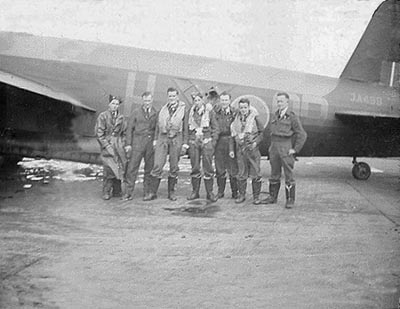
He said
it disturbed him for quite some time after.
At 11
OTU RAF Oakley (Bucks) he converted to Wellington MK X’s. The squadron hack was
a MK II Hurricane and Tink was told to “go do some circuits” which he did with
some serious enthusiasm, “somewhat quicker than the 50 hp Cub!” he said.
For him
personally, the only real incident of the war happened while on a night flying
exercise, the Wellington he was landing ran out of brakes before the end of the
runway arrived and they careered off the end to be violently stopped when the
main wheels dropped into a perimeter defence trench. He suffered a broken finger
that stayed bent for the rest of his life.
His
final posting was to 1576 H.C.U. at Abu-Sueir Egypt for conversion to
Liberators. The squadron was being readied to support the American effort in
South East Asia when the balloon went up and they shipped the boys home via
Australia.
After the war he kept his license current and
qualified as a commercial pilot with the intention of immigrating to Canada to
apply his skills. Luckily for me my mother turned his head and he followed his
heart, joining his father’s architectural practice and stayed local. Wildly
passionate about racing motorbikes he won a number of national titles for
circuit racing and trials riding. He continued with his PPL flying until the
family owned Piper J3 was sold in 1960.
21st November 2011
‘S’ for ‘Sugar’
Martin Willoughby Barnes Wallis and Bomber
Harris
What follows is the unique
and amazing story of a valued customer and friend Martin Willoughby who met
some of the legends of Great Britain, Sir Barnes Wallis most famous for
designing the Bouncing bomb and Sir Author Bomber Harris who took the war to
the enemy in a time when Bombing was the only way for Britain to wage war
against the Nazi war machine. His father played a major role in the
preservation and restoration of the famous S for Sugar Lancaster.
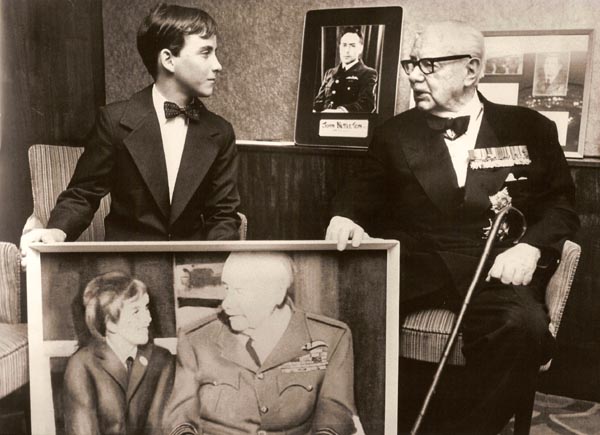
Above a Young Martin with Sir
Barnes Wallis holding a picture of himself with Sir Author Bomber Harris.
I have been asked to tell the story
behind my interest in RAF Bomber Command and in particular my connection with
the Avro Lancaster now on display at the RAF Museum, Hendon.
It all started in 1969, when I went on a journey with my
dad to RAF Scampton in Lincolnshire. The purpose was to identify the Lancaster
which resided there as gate guardian. I was 4 years of age and did not really
understand why we were there at the time, but for my dad it was to be the end
of many years of searching for his old aircraft. My dad’s introduction to
aviation was at the age of 14 when he worked at the Short Seaplane works at
Rochester, building radial engine cowlings. He naturally went on to join the
RAF in 1939, and served as an engine fitter on 463/467 Sqns at Bottesford (and
later on at Waddington, when the squadrons moved there in 1942). Dad’s
Lancaster was the 27th built and was originally laid down as an Avro
Manchester. It was produced at t he Metropolitan Vickers Works, Mosley Road,
Trafford Park, Manchester and was delivered to 83 Sqn at Scampton in 1942
where the code letters OL-Q were applied.
It was later transferred to 467 Sqn at Waddington and my
dad was there to receive it when it was delivered by the ferry pilot (who told
him that it was finished, fit only for the scrap heap!). However, this was not
to be, and from then on until the end of the war my dad was responsible for
maintaining and repairing its engines, and is one of a very few people to have
had constant contact with the aircraft as crews came and went.
The code letters PO-S were applied to the fuselage and
the aircraft became affectionately known as S ‘Sugar’ - the nose art at
delivery depicted a red devil dancing in flames and thumbing his nose, with
the motto "Devils of the Air" beneath it (the devil was ‘Mestophelise’ to whom
Faust sold his soul in German legend). This was later painted out and replaced
with the image of a naked lady holding and about to drop a bomb.
Losses were high during the war, the worst years
being 1943/44, and by the end of the Second World War over 55,000 airmen had
lost their lives on Bomber Command alone. To put that figure into context it
is now greater than the operational strength of the RAF today, in 2011.
As time went on people began to get a feeling that this
was no ordinary aircraft. The bombing missions began to mount up and ‘Sugar’
seemed indestructible. She had a bomb that was being loaded on to her
accidentally dropped and it did not blow up, and when she collided over Berlin
with another Lancaster she made it home. On another occasion, when during
evasive action in the attempt to get away from a night fighter the pilot had
to push the aircraft to the limits of its endurance, the crew heard what they
believed to be machine gun fire - it was in fact hundreds of pop rivets being
torn from their mountings!
Because the propaganda machine began to recognize
the value of such an aircraft the naked lady nose art had to go and was
replaced by one bomb for each operation completed. At that time my dad had
been reading a ‘Readers Digest’ and saw a quotation by Hermann Georing in
which he said to the German people "NO ENEMY PLANE WILL FLY OVER THE REICH
TERRITORY”.
He requested that he be allowed to apply this to the nose
art signed with the authors name and got his wish; however my dad spelt
‘Hermann’ with only one ‘n’ - a mistake that remains to this day. Lancaster ‘S
– Sugar’ at the RAF Museum, Hendon
By Martin Willoughby
William Joyce alias Lord Haw-Haw (who was later hanged
for broadcasting German propaganda) broadcasted that when the notorious German
Army marches through Great Britain that the airman responsible for this
outrage ‘will pay’ for his actions. ‘Sugar’ went on to become the first bomber
to reach 100 ops, surviving a sustained attack by two Ju88 night fighters.
Upon her return a scaffold was erected alongside the cockpit on which the
seven man crew (captained by Fg Off Schofield) stood and were toasted by the
Squadron. ‘Sugar’ also went nine times to Berlin;
Crews begged to fly in her and the in joke was that she
did not need a navigator because she knew her own way home. She dropped her
last bombs on Czechoslovakia completing an incredible 137 operational sorties.
With the war over my dad went back to civvy street and
that should have been the end of the story. As the years went, on my dad began
to wonder what had happened to ‘Sugar’ and whether or not she had been broken
up without thought. He had made several fruitless enquiries and was about to
give up when he was informed that there was a Lancaster at the gate at RAF
Scampton. However he was told that it had the wrong code letters on it to be
‘Sugar’ which brings me back to the start of the story my journey to
Lincolnshire - you see my dad had decided that it was worth a trip to see this
mysterious Lancaster anyway.
On our arrival approaching Scampton’s gates from the
south the Lancaster came into view and the disappointing code letters OL-Q
could be seen. However, as we turned into the gate the familiar nose art with
the bombs and the Georing quotation were apparent and on gaining entry my dad
went straight to the tail number which identified the aircraft beyond doubt -
it read R5868.
My dad could not believe his eyes! His Lancaster had
survived everything, even the scrap yard, which when you consider it was just
one of over 7000 Lancaster's built seemed unbelievable. We later discovered
that 83 Sqn were at Waddington flying Vulcan's, and when they was realized
that ‘Sugar’ had started her career on 83 Sqn the old OL-Q code letters were
reapplied hence the confusion over her identity. We went onboard and were met
with a scene of decay and neglect, all of the internal components had been
removed for PA474 (the only flying example at that time), and ‘Sugar’ was in
poor condition.
Permission was gained for my dad to carry out a
restoration project on the aircraft and many trips were made to work on her
and obtain missing parts. My dad had his heart set on ‘Sugar’ going into the
new RAF Museum at Reception following the 100th sortie A famous wartime
publicity photograph: ‘100 Not Out’
‘S’ for ‘Sugar’ suggestion to the MOD. After many months
of wrangling he was contacted by Dr John Tanner, the new Museum’s top man, who
informed him his wish would come true. Before ‘Sugar’ was dismantled in 1970,
the Station Commander asked if he could do anything for my dad to show his
appreciation.
My dad requested an entire squadron of Vulcan's to fly
low over ‘Sugar’ for a photo opportunity. The Station Commander was not amused
and dismissed the request pointing out the massive cost of such a task. After
a few days had passed, my dad was contacted and told he could, however, have
one Vulcan for the purpose. ‘Sugar’ was then transported to Hendon via
Bicester and Northolt and after many years of spending long weekends
manufacturing parts, scratch rebuilding, fitting and collecting parts with my
dad, it still brings a tear to my eye when I turn the corner and see ‘Sugar’
proudly dominating the entrance to Bomber Command Hall in all her glory.
Her restoration was complete and she remains at
Hendon for all to see and hopefully for all to remember the sacrifice made by
all in that bombing campaign of many years ago.
Some of the more memorable moments for me over those
years were from meeting famous people that are still to this day icons within
the aviation community. I was lucky to come into contact with people such as
‘Bomber’ Harris, Barnes Wallis, Bob Stanford Tuck, and Nicholas Alkomade (who
jumped out of a burning Lancaster at 18000 ft without a parachute and
survived).
During the numerous reunions to which I was invited
I often met Sir Arthur ‘Bomber’ Harris, MRAF. He took a shine to the young
Willoughby and made me promise that I would one day join the RAF - hence you
know who to blame! I can recall he also asked me to reply to a question by
post - the question was “what's the difference between a man of Kent and a
Kentish man?” The answer of course is that they live on opposite sides of the
river Medway. I sent the letter and was sent by return of post an autographed
war time photo of him.
He jokingly told my dad if I ever came up for
adoption he would adopt me. Surprised I was! I saw him as a mild mannered old
gentleman. Who held the total commitment and loyalty of the men and
women under his command.
They affectionately referred to him as “Butch” during the
dark days of the Second World War and to this day I have yet to meet a veteran
who does not vigorously defend his actions in respect of the bombing
offensive. A painting of me with Bomber Harris was commissioned and presented
at the Grosvenor Hotel, Park Lane, London.
My dad also made the acquaintance and later worked with
Sir Barnes Wallis. He built the Mk2 catapult with which Sir Barnes launched
models of his hypersonic aircraft down his garden. On my many visits to his
house Lady Mary Wallis would stuff me with chocolates in front of their open
fire and regale me of stories of the war.
At the age of ten I can recall my first meeting
with Sir Barnes and can remember saying to my dad that he seemed such a nice
person that I felt sorry for him. I think his personality made him seem
vulnerable in some way and, as depicted in the Dambuster film, I can imagine
his torment over the loss of the crews that took part in the Dams raid.
Following his death I was invited to the requiem mass that took place in St
Paul's and remember sitting only a few seats away from his other biggest
supporter, Prince Charles.
It never ceases to amaze me that people still seem
as interested in this subject now as they were in the 1970’s, and the older I
get the more I seem to get involved. I was recently asked to give an hour long
talk on the history and restoration of ‘Sugar’ by the Museum at RAF Welford (USAF).
I was given such a warm welcome and the interest
was so great that they have invited me back. It’s nice to see what a good job
they have done in preserving the memory of our heritage for future generations
to see, and because of my dad’s efforts in respect of preservation this is of
great importance to me. So now you know why I am so interested in that era and
why I am always happy to be a part of an Honour Guard, and why I will always
have time for the 624 Sqn veterans. Simply because I have been lucky enough to
have had a unique insight into that period of history, as well as much
personal contact with the aircraft, the aircrew and ground crews of the most
famous Lancaster of them all - ‘S for Sugar’. SAC Martin WILLOUGHBY
I am hugely
grateful to Martin for allowing me to publish his story on the website.
Graham
Adlam Spitfire Spares owner


|
|
